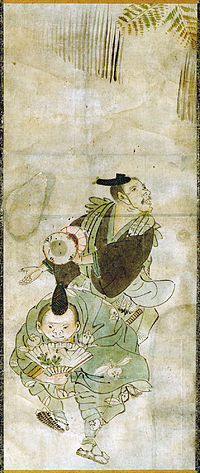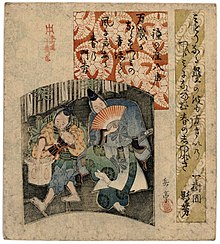Manzai

Manzai (
Manzai usually involves two performers (manzaishi)—a straight man (tsukkomi) and a funny man (boke)—trading jokes at great speed. Most of the jokes revolve around mutual misunderstandings, double-talk, puns and other verbal gags.
In recent times, manzai has often been associated with the Osaka region, and manzai comedians often speak in the Kansai dialect during their acts.
In 1933, Yoshimoto Kogyo, a large entertainment conglomerate based in Osaka, introduced Osaka-style manzai to Tokyo audiences and coined the term "漫才" (one of several ways of writing the word manzai in Japanese; see § Etymology below). In 2015, Matayoshi Naoki's manzai novel, Spark (火花), won the Akutagawa Prize.[2] A mini-series adaptation was released on Netflix in 2016.
History
Originally based around a festival to welcome the New Year, manzai traces its origins back to the Heian period. The two manzai performers came with messages from the kami and this was worked into a standup routine, with one performer showing some sort of opposition to the word of the other. This pattern still exists in the roles of the boke and the tsukkomi.

Continuing into the
With the end of the
Etymology
The kanji for manzai have been written in various ways throughout the ages. It was originally written as lit. "ten thousand years" or banzai, meaning something like "long life" (萬歳), using 萬 rather than the alternative form of the character, 万, and the simpler form 才 for 歳 (which also can be used to write a word meaning "talent, ability"). The arrival of Osaka manzai brought another character change, this time changing the first character to 漫.
Boke and tsukkomi
Similar in execution to the concepts of "funny man" and "straight man" in double act comedy (e.g. Abbott and Costello), these roles are a very important characteristic of manzai. Boke (ボケ) comes from the verb bokeru (惚ける/呆ける) which carries the meaning of "senility" or "air headed-ness" and is reflected in the boke's tendency for misinterpretation and forgetfulness. The word tsukkomi (突っ込み) refers to the role the second comedian plays in "butting in" and correcting the boke's errors. In performances it is common for the tsukkomi to berate the boke and hit them on the head with a swift smack; one traditional manzai prop often used for this purpose is a pleated paper fan called a harisen (張り扇).[8] Another traditional manzai prop is a small drum, usually carried (and used) by the boke. A Japanese bamboo and paper umbrella is another common prop. These props are usually used only during non-serious manzai routines as traditional manzai requires there to be no props in terms of routine and in competitions. The use of props would put the comedy act closer to a conte rather than manzai.
The tradition of tsukkomi and boke is often used in other Japanese comedy, although it may not be as obviously portrayed as it usually is in manzai.[citation needed]
-
Hanabishi Achako and Yokoyama Entatsu established the talk show-centered manzai style. They were active since 1919.
-
"All Hanshin-Kyojin", active since 1975
-
"Wagyu", active since 2006. Manzai actors often work as multi-talents.
Notable manzai acts
- Downtown
- Cocorico
- Takeshi Kitano; Japanese film director, television host, and former manzai performer in the group "Two Beat". Manzai is mentioned and referenced in a number of his other works.
- Gen Takagi
Literary associations
- Buson more positively wrote: "Yes, New Year's dancers – / Pounding good and properly, / The dirt in Kyoto".[10]
See also
- The Manzai Comics – manga series about a young manzai duo
- Double act
- Nininbaori
- Kyōgen
- Rakugo
- Owarai
- Xiangsheng – the Chinese analogue to manzai.
- Spark (火花) – a 2015 novel about two manzai artists
- M-1 Grand Prix – the most prevalent manzai competition in Japan
References
- ^ Blair, Gavin (2016). "What's Manzai?". Highlighting Japan June 2017. Public Relations Office of the Government of Japan. Retrieved 4 November 2019.
- ^ Kyodo, Jiji (17 July 2015). "Comedian Matayoshi's literary win offers hope for sagging publishing industry". Japan Times. Archived from the original on 27 August 2015.
- ^ Hiragana lesson through Japanese culture – manzai
- ^ Manzai (Double-act comedy)
- ^ Japanese yose theater – Japanese comedy shows Archived 3 November 2007 at the Wayback Machine
- Japan Times, 25 May 2012, p. 13
- ^ Ashcraft, Brian, "Ni no Kuni’s Funny Bone Has Quite the History", Kotaku, 5 October 2011
- ^ WWWJDIC Archived 3 January 2015 at the Wayback Machine
- ^ L Zolbrod, Haiku Painting (1982) p. 16
- ^ L Zolbrod, Haiku Painting (1982) p. 16
External links
- What is Manzai 2015 archive
- "Commodified Comedians and Mediatized Manzai: Osakan Comic Duos and Their Audience" by Xavier Benjamin Bensky. A study in the cultural effects of manzai.



